January 2000 (Part 3)
SELECTION OF QUESTIONS AND ANSWERS
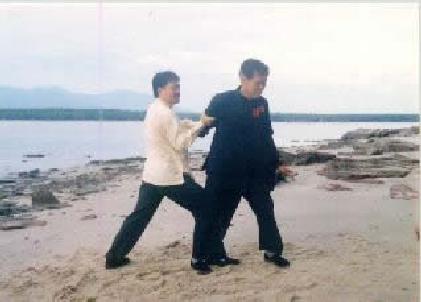
Goh Kok Hin grips Sifu Wong's right arm
Question 1
In your Shaolin Kungfu book you gave a description of your lineage directly from the Fukien (Southern) Shaolin Temple. Such masters are extremely rare, and it would be extremely beneficial as a reference for future generations if you could provide a description of the original kungfu sets that were taught in the Fukien Shaolin Temple
— Marlene, Australia
Answer
It is not feasible to list all the kungfu sets taught in the Fujian (Fukien) Shaolin Temple. Even if it were feasible, it would not be useful. The reasons are as follows.
Different kungfu sets were taught by different masters at different times in the Temple. Hence, the sets taught in one school may be totally different from those taught in another school, even though both schools genuinely descended from the Shaolin Temple.
Both my masters, Uncle Righteousness and Sifu Ho Fatt Nam, were direct descendants from the Southern Shaolin Temple, but the kungfu sets they taught were different. For example, from Uncle Righteousness I learned “Tiger-Crane”, “Flower Set” and “Dragon Strength”, whereas from Sifu Ho Fatt Nam I learned “Four Gates”, “Seven Stars” and “Lohan Set”.
Interestingly, my kungfu students today, unlike those of my earlier days, do not learn these sets, but their kungfu progress is probably three times better than their earlier brethren. This is because through the years I have improved my teaching, and now I focus on combat application and internal force training rather than set practice.
Actually it is not what kungfu sets you know, but how you perform them, that is important. Most Shaolin kungfu sets today are derived from the Shaolin Temple or are closely linked to it, but for various reasons they are today mostly performed as gymnastics. In Yang Style Taijiquan the 108-pattern set played by many people today was actually invented by the great Taijiquan master Yang Deng Fu, but while the master practised it as a martial art, modern players performed it as a dance, sometimes with music accompanying.
There is a far better method than checking kungfu sets to ascertain whether a certain kungfu style is genuinely Shaolin. The hallmarks of Shaolin Kungfu are combat efficiency, internal force training and spiritual cultivation. If someone has practised a style for a few years, yet cannot use it for combat, it is certain that his is not Shaolin Kungfu. It might have originated from Shaolin in the past, but somewhere down the generation line, it has degraded into gymnastics or dance.
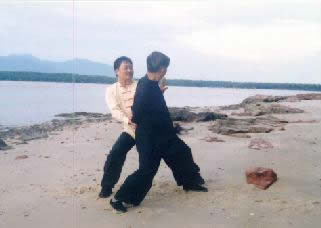
Sifu Wong bends his elbow and turns his body to neutral the grip
Question 2
There are wushu instructors who insist that their art is also directly from the Shaolin Temple. Without a genuine point of reference such as that which you can provide, many enthusiasts will also be mistaken. I know that these instructors are wushu exponents because they confirm their adequacy by mentioning their membership in wushu teams in mainland China, bronze medal awards, etc.
Answer
Modern wushu is not Shaolin Kungfu. About the 1960s the Chinese government gathered together some kungfu masters of various styles with the objective of synthesizing the various styles into one uniform style, which is today's modern wushu. Prior to that, there were numerous kungfu styles like Lohan, Praying Mantis, Eagle Claw, Chaquan, Huaquan, Hoong Ka, Wing Choon, Hsing Yi, Pa Kua, etc. After that, there was to be no differentiation into these various styles, only wushu.
Wushu was invented solely for sports, and never as a martial art. For the purpose of competition, wushu was divided into seven categories, namely
- Changquan, or Long Fist
- Nanquan or Southern Fist
- Daoshu or Knife Techniques
- Jianshu or Sword Techniques
- Kunshu or Staff Techniques
- Chiangshu or Spear Techniques
- Taijiquan or Tai Chi Chuan
The sole criterion for the award of points in all wushu competitions is how graceful and elegant the performance is, and never how well a performer can defend himself or how much internal force he has.
The wushu instructors were quite right to say that wushu was derived from Shaolin Kungfu because except for Taijiquan and aerobatic movements, virtually all wushu movements were taken from Shaolin Kungfu. But their statement is misleading, as their nature and purpose are very different.
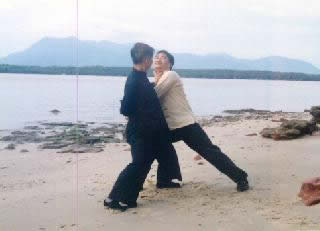
Continuing the turn, Sifu Wong grips Goh's throat in a Shaolin pattern called “Golden Cockerel Locks Throat” (Pattern 35 of the 72 Chin-Na Techniques)
Question 3
Also, a kungfu master insisted that Chinese martial arts are all called wushu; kungfu is only a Cantonese term meaning hard work.
Answer
From one perspective he is right, but from another perspective — the one we are using now — he is wrong. The sameness or difference between kungfu and wushu has confused many people, but the following explanation will clear the confusion.
Kungfu, used in the sense of Chinese martial art, has many terms in the Chinese language. The present official term is “wushu”. Besides this term, another term that is most commonly used for what in the West would be conceptualized as “kungfu” is “quanfa”, often shortened to “quan”. Thus, Shaolin Kungfu is “Shaolinquan” or “Shaolin wushu” in Chinese, and Tai Chi Kungfu is “Taijiquan” or “Taiji wushu”.
It is also true that in Cantonese, as well as many other Chinese dialects including Mandarin, “kungfu” literally means “work”. But today when a person uses the word “kungfu”, he usually means “martial art”, using the term “kung-chok” (or "gong zuo" in Romanized Chinese) for “work”.
Complications started when the present Chinese government promoted newly invented modern wushu as a sport, and not as a marital art. The trend has been so established that today when the term “wushu” is used, especially in the West, it is conceptualized as a demonstrative sport, whereas when the term “kungfu” is used it is conceptualized as a martial art.
In other words, we now have an interesting situation whereby although the word “wushu” literally means “martial art”, in practical usage it is a demonstrative sport; and although the word “kungfu” literally means “work”, it is a martial art. To say that all Chinese martial arts are wushu is like saying all persons are men, insisting that the word “mankind” refers to humankind.
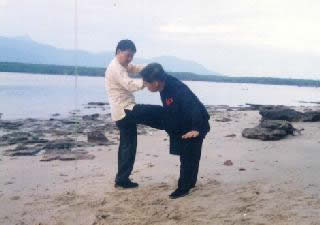
Goh Kok Hin holds Sifu Wong's right arm and simultaneously kicks Sifu Wong's ribs with his right knee.
Question 4
You mentioned that Shaolin is famous for its 72 chin na techniques. Can you list them please? It is extremely rare to find a knowledgeable master to ask, and having found one I really would like to ask you.
Answer
Different masters during the same or at different periods have different sets of 72 chin-na (or "qin-na" in Romanized Chinese) techniques. Mine are as follows. The pronunciation is in Cantonese, followed by its English translation. Because of cultural and linguistic differences, some names may sound funny, but in Chinese they are both poetic and meaningful.
- tan fu chuit toong -- Single Tiger Emerges from Cave
- hak fu sai jow -- Black Tiger Cleanses Claws
- tai ma kwei choe -- Lead Horse Back to Stable
- kam loong thow lea -- Golden Dragon Shoots Tongue
- lo han fok fu -- Lohan Tames Tiger
- wan sau yin jow -- Circling Hands Eagle Claws
- tok kheuk thai kham -- Single Leggedly Lift Guitar
- mei lui kow sar -- Beautiful Girl Turns Shuttle
- sap tze khow sau -- Cross-roads Hand Locks
- pak hou man chi -- White Ape Grips Branch
-
tai kung tiew yu -- Grand Old Man Catches Fish
- kwan pheng pou yein -- Kwan Pheng Carries Insignia
- ngo fu pang lan -- Hungry Tiger Leans against Fence
- phat fu mei sei -- Pull a Tiger's Tail
- chow chong fu mei -- Running with a Hidden Tiger's Tail
- thien pheng sau fatt -- Hand Technique of a Balance
- lou yin kham seai -- Old Eagle Catches Snake
- lo han khaik ku -- Lohan Strikes Drum
- kam kong fok fu -- Immortal Tames Tiger
- lan kong chit pa -- Block the Big Boss
- yap hoi kham kow -- Enter Sea to Catch Monster
- siew ping tham san -- Small Soldier Carries Umbrella
- sin yein tham chai –- Immortal Carries Sticks
-
see ku tham san -- Nun Carries Umbrella
- chor seong thok cheong -- Sitting Double Lifting Palms
- seong loong fok kow -- Double Dragons Subdue Monster
- yok lui choi fa -- Jade Girl Plucks Flower
- yein foong whet lou -- Bending Willow in the Wind
- chin see sau fatt -- Cocoon Hand Technique
- fan chin see sau -- Counter against Cocoon Hand
- fok teai choi fa -- Squarting to Pluck Flower
- kok kow kap pan -- Immortal Plays Clappers
- kam tong lei fatt -- Golden Boy Worship Buddha
- fok teai ow lin -- Squarting to Bend Lotus
- kam kai sor hou -- Golden Cockeral Locks Throat
-
yin jow kham loong -- Eagle Claw Catches Dragon
- seong loong pou chui -- Double Dragons Carry Pearl
- ku shue fan kein -- Rotten Tree Exposes Roots
- kam sin thiew lou -- Golden Thread Hangs Gould
- fok teai sor hou -- Squarting to Lock Throat
- kam see phan mei -- Golden Bird Grips Eye-Brow
- ngo yin pok shek -- Hungry Eagle Charges at Prey
- lou chang mo mai -- Old Monk Grinds Rice
- ling hou chak kor -- Spiritual Monkey Plucks Fruit
- seong kung pou yuit -- Double Bows Carry Moon
- seong loong hei shui -- Double Dragons Play with Water
- tou seet ngo mei -- Reverse showing of Bull's Tail
-
khay loong choi kein -- Riding a Dragon to Pull Tendons
- yi fu hong loong -- Two Tigers Subdue Dragon
- mang fu fok teai -- Fierce Tiger Crouches on Ground
- ngo fu thui chow -- Hungry Tiger Retreat from Den
- siew kwai thuit heur -- Little Devil Removes Shoes
- pak yun sheong shue -- White Ape Ascends Tree
- pak hou kham chi –- White Monkey Catches Boar
- hou tze thou thow -- Monkey Steals Plum
- yip tai thou thow -- Stealing Plums Under Leaves
- sin yein chak kair -- Immortal Plucks Tomatoes
- hoi teai lau yuit -- Bail Moon from Sea Bed
- san choong kham fu -- Catch Tiger in Mountain
-
yip teai choi lin -- Under Leaf Pluck Lotus
- khan sun fu jow -- Near Body Tiger Claw
- yi ku na cham -- Second Auntie Grips Crab
- pak fu hein jow -- White Tiger Present Claws
- mang fu sai jow -- Fierce Tigers Cleanses Claws
- hak fu tong moon -- Black Tiger Guards Door
- cheong khun tai ma -- General Leads Horse
- lo han pou fatt -- Lohan Embraces Buddha
- tong ping lau hak -- Tang Soldier Keeps Guest
- fok fu thean foong -- Tame Tiger Listen to Winds
- mang fu foo yu -- Fierce Tiger Crouching at Clif
- mang fu ha san -- Fierce Tiger Descends Mountain
- ngo fu kham yeong -- Fierce Tiger Catches Goat
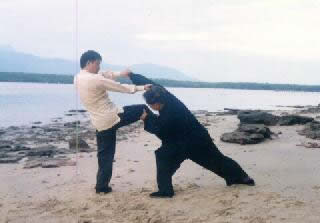
Sifu Wong moves his righ leg a big step backward to avoid the whirl-wind kick. Using a circular movement he releases Goh's hold and immediately grips Goh's right knee with his left Tiger-Claw
Question 5
Also, as a genuine and experienced Chi Kung master, what is your opinion on the following quoted comment?
“Traditional chi kung does not involve visualizing ... it is not specifically mentioned in the chi kung classics. At most, it is only briefly hinted at — and even this reading requires a subjective interpretation. Visualization is the product of a modern era of chi kung practitioners, is not as well time-tested, and some medical practitioners have encountered patients with psychiatric disorders after a period of chi kung practice. There are even reports of people being 'possessed'. Original chi kung was only physical exercise — meaning movement and breathing coordination exercises....”
Answer
The quoted comment is factually wrong in many places. I shall deal with the points one at a time.
“Traditional chi kung does not involve visualizing”.
This is factually wrong. All chi kung — real chi kung, and not just chi kung external forms — deals with mind, energy and physical body. Much of the mind aspect concerns visualization. For example, when a practitioner performs a simple movement, such as moving his arm outward, he “thinks” of chi flowing to his arm and fingers. This is visualization. At the end of an exercise, he stands still and “thinks” of his abdominal dan tian (energy field). This again is visualization.
I place “thinks” within inverted commas because it is not conscious or intellectual thinking; it is intuitive thinking, or visualization.
“It is not specifically mentioned in the chi kung classics. At most, it is only briefly hinted at — and even this reading requires a subjective interpretation.”
This again is factually wrong. Most chi kung classics mention visualization; many deal with it explicitly and in great details. Here are two random examples.
The “Jade Pendant Song of Chi Circulation” states as follows: “when long, retreat; when retreat, heaven”.
This is a very concise way of saying “when the chi at the abdominal dan tian has become abundant, let it flow down to the hui-yin energy field; when it has accumulated at the hui-yin energy field, let it flow up to the bai-hui energy field at the crown of the head”. This describes the training of the Small Universe, and is effected through visualization.
The jade pendant on which the “Jade Pendant Song of Chi Circulation” was engraved, is an archaeological treasure belonging to BCE 380. It is the oldest record of chi kung extant today.
The following “Method of Taking Sun Energy” is recorded in a Taoist chi kung classic.
“At dawn. When the sun just rises. Face the sun. Sit or stand, according to wish. Bite teeth nine times. Breath out from the heart. Close eyes. Visualize majestic, pearly scenery of the sun shining beautifully over the green. Let the rays flow to you, a naked child. Spiritual splendour. Keep the colourful flowing mist in your eyes. Soak into your body. Down to your two feet. Up to the crown of your head. Also in the bright shine, visualize purple energy, like eyes of a child.”
(Note: do NOT practise this method on your own.)
“Visualization is the product of a modern era of chi kung practitioners, is not as well time-tested”.
The nature, quality and methods of visualization were unquestionably higher in the past than today. Most modern practitioners do not know how to visualize; rather they intellectualize, and they do not know the difference.
The visualization methods are well time-tested. This claim can be verified not only in established chi kung records but also in practical experience. For example, using appropriate visualization methods passed down the centuries by past masters, students who took intensive chi kung courses from me could tap energy from the cosmos, directed it to where they wished, and massaged their internal organs. If the visualization methods were not effective, my students could not have those skills, and they would not happily pay US$1000 for a three-day course.
“and some medical practitioners have encountered patients with psychiatric disorders after a period of chi kung practice. There are even reports of people being possessed”.
“Chi kung practice” above should read “wrong chi kung practice”. This is not surprising when so many people, especially in Western societies, think that by learning from books or videos they can do as equally well what masters or properly trained practitioners do.
I would not be surprised if some people, despite my warning, practise on their own the Taoist method of taking sun energy described above. After a few weeks, or even a few days, they might teach others, in the grandiose idea of “sharing”. They and their foolish students simply cannot accept the fact that advanced internal arts have to be learnt from a master. They are likely to have, and cause other to have, physical as well as psychiatric disorders.
But if chi kung is practised correctly, it is excellent for overcoming psychiatric disorders and the state of being possessed. In my opinion, chi kung is more effective than psychiatry for overcoming these health problems. Psychiatric disorders are problems of consciousness, and being possessed are problems of the spirit. Psychiatry, a branch of modern Western medicine, addresses a patient at the physical level only, and has neither the concept nor the vocabulary for anything dealing with consciousness or spirit.
On the other hand, chi kung takes into account all the three dimensions of a person, namely his physical body, his energy and his spirit, which includes his consciousness. From the chi kung perspective, even if a person's physical body is not ill, he still cannot be considered healthy if his energy is insufficient, or his spirit or consciousness is disturbed.
“Original chi kung was only physical exercise — meaning movement and breathing coordination exercises...”.
The person who made this statement, even though he might be called a chi kung “master”, does not know what chi kung really is. “Chi kung” literally means “energy work”. Hence, for any art or exercise to be called chi kung, the practitioner must work on his energy, not just on his physical body. If he does not actively, consciously work on his energy, even though the exercise he is performing is a genuine chi kung exercise, he would have debased it into physical exercise or breathing exercise. This, I believe, is the main contributing factor why much of chi kung today has become gymnastics or dance.
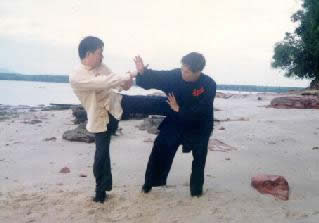
Goh Kok Hin grips Sifu Wong's right wrist and attacks Sifu Wong's right ribs with his left shin using a whirl-wind kick
Question 6
Looking at the Hung Gar applications demonstrated in the Combat section, I was quite disturbed. What is disturbing is to see some of the most unrealistic and unusable applications for the techniques demonstrated. If anyone attempted to use the applications given for those techniques in a true fight, against an opponent who intends to kill, they would fail.
— Mike, USA
Answer
The techniques are not my invention; they have been evolved over many centuries as a result of actual fighting. In other words, they did not just come out of the blues, or out of someone's imagination or thinking. These techniques came about from real uses in serious combat, often with life-death consequences.
Initially, fighting techniques were straight-forward, not much different from those used by children or untrained persons today. Gradually over many centuries the techniques became more refined. Unlike you, lucky enough to live at a time and in an environment when and where fighting is uncommon, and hence whether these techniques are realistic and usable are merely an academic question, the Hung Gar masters in the past, from whom we inherit the techniques, took the techniques in dead seriousness. If the techniques they practised were unrealistic or unusable, they might have to pay with their lives.
Thus, you can be assured that all the patterns that have survived the test of time and come to us in established kungfu sets, are effective and usable. But due to our different conditions, the great majority of people who practise kungfu today, including some so-called masters, do not know, even in theory, the uses of most kungfu patterns.
If you find these techniques, which represent some of the distillation of real fighting experiences of past masters, unrealistic it is due to your lack of knowledge; if you find them unusable it is due to your lack of skills. But you are not alone in such thinking. Many people, including some “masters”, think that traditional kungfu is unrealistic and too flowery for fighting. To them fighting is mainly free exchanges of blows and kicks.
I am very lucky to have been trained in the traditional way — which includes actually using those techniques to fight — and I am much disturbed that kungfu is fast becoming a dance. Explaining the uses of these patterns in my webpages is an attempt to preserve some essence of traditional kungfu.
The two patterns I explained in the Combat section — “Black Tiger Breaks Flank” (also known as “Immortal Tames Tiger”) and “Fierce Tiger Crouching at Cliff” — are found in the famous Tiger-Crane Set, the most fundamental set in Hung Gar Kungfu. As you have practised Hung Gar Kungfu for many years, you must have performed these two patterns, and similar patterns which you might consider “unrealistic and unusable”, many, many times.
Have you ever wondered why these patterns are included in the Hung Gar sets, and why you practise them? And if you spar, can you use the patterns you have learnt in your solo practice? It would be much more disturbing if you had performed unrealistic and unusable Hung Gar patterns for years.
There is one significant point you seem to have missed, and which is emphasized on the main page of my Combat section, namely knowing and applying techniques is only one of many factors in effective combat. Other factors include force, timing, spacing, judgement and fluidity of movement.
There are many possible reasons why you find the techniques unrealistic and unusable. Two obvious reasons are that you do not believe they can be used in such ways, and that you have never used them in sparring or fighting. The following is a simple method to test your belief and application.
Have someone throw a punch at you. Grip his wrist with one hand, and strike his elbow with your bent forearm, as in the pattern “Black Tiger Breaks Flank”. Be warned — this technique is very effective. Make very sure that you do not break or dislocate your partner's elbow. Practise this, and nothing else, fifty times daily for three months. If you think this is crazy, you have no idea what traditional kungfu training is, and might have treated it like a party game.
But you will be well rewarded. After the three months, when you spar with those of your level you will find that you could easily break the arms of those who throw punches at you. And you have only trained for three months. When you reflect that the past masters had trained for thirty years, you will realize that their techniques were realistic and usable, and also why modern martial artists could not be any match at all against the past masters.
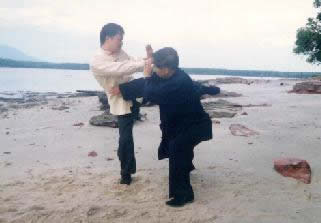
Sifu Wong moves his left leg a big step to his left side, thus avoiding Goh's left whirl-wind kick, and simultaneously grips Goh's right ribs with a right Tiger-Claw in a pattern called “Enter Sea to Search for Pearls”.
Question 7
In the future, perhaps it would be better to show techniques being used against someone who is:
- close enough to strike the defender
- using something other than a very basic and straightforward hand attack
- without assistance from their martial hand
- attacking an appropriately vulnerable area
Answer
Your suggestion is irrelevant, as all the these points you mentioned are already incorporated in the examples in question.
Spacing is a very important factor in combat. The attacker must be close enough to execute an effective strike but far enough to avoid a sudden counter attack. If in an illustration an attacker appears to be too far from the defender, it is because the defender has moved away to avoid the full force of the attack, or for other reasons. If you did not realize this point, it was probable that as your sparring consisted mainly of exchanging blows and kicks, you had never considered this technical factor.
Both straight-forward as well as complex attacks are illustrated in my webpages. Straight-forward attacks, like the thrust punch, are more often used because most attacks used by martial artists today are straight-forward. If complex attacks are illustrated, you might consider the Hung Gar counters even more unrealistic and unusable. I do not understand what do you mean by “without assistance from their martial hand.”
A thrust punch to the solar plexus, or a palm chop at the colar bone is attacking an appropriate vulnerable area. The former strike can be fatal, and the latter strike can disable an opponent. If the palm chop is aimed at the head instead of at the colar bone, it can also be fatal.
Is Shaolin Kungfu too Flowery for Combat? will give you some idea that what you thought was unrealistic is actually very practical and effective if you know how to and can skillfully use it.
Question 8
I am a Taijiquan practitioner. I practice the 24-form Yang style and the 40-movement competition form. I also practice small san sau. My question is: how do you teach a beginner in taiji who does not have any knowledge in the martial art how to fight? Is there a method of basic training to teach him how to punch, kick or block?
— Zamir, Israel
Answer
Taijiquan is basically a martial art. Different Taijiquan masters may teach differently, but if you learn from any one of them — so long as he teaches Taijiquan and not Taiji dance — you will know how to fight.
Taijiquan is very rare today. What the great majority of people practise today, and that probably includes you, is strictly speaking not Taijiquan, but some external Taiji forms which for convenience I call Taiji dance. Had you practised Taijiquan, you would not have asked me the question; you would also know there is no such a person as a beginner in Taijiquan who does not have any knowledge of the martial art, because Taijiquan is a martial art.
The fact is most people practise Taiji dance, but they honestly think it is Taijiquan. But Taiji dance is not without its benefits, and for some people it may be a better choice than Taijiquan.
I would not answer the question how I would teach a Taiji dancer how to fight, as this would take time and he has to attend my Intensive Taijiquan Course. Or he can attend a regular class taught by one of our Taijiquan instructors.
I would help him to convert his Taiji dance to Taijiquan, and I would touch on all its four dimensions of philosophy, form, force training and application. He will perform his Taiji form as a means to train energy and mind, and not merely as physical exercise or dance.
If he has any health problems, the emphasis will be on energy flow to overcome his health problems. If he is already healthy and fit, the emphasis will be developing internal force. Only when a person is healthy, fit and has some internal force, should he pay more attention to combat efficiency.
He will learn how to use Taijiquan technique, tactics and strategies to fight. There are numerous methods to teach him how to punch, kick and block, but these methods are very different from what you and many other people may conceptualize them to be. He would not, for example, punch, kick and block as in karate, taekwondo or children's fighting.
Applying the Taijiquan tactic of flowing with the opponent, he would not clash head-on with his opponent, but manoeuvre his opponent into an unfavourable position before he makes his strike, not with mechanical strength but with internal force. It will take time and effort, but if he practises about an hour a day, he should be able to handle a black-belt in a year.
